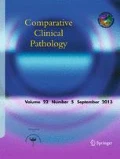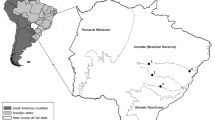Abstract
In additional to significant dietary, lifestyle and hormonal differences, stray cats may have different hematological parameters from pet cats. The objectives of this study are to determine hematological reference intervals (RIs) from a large population of stray cats in northern Italy, to establish whether published RIs for the general pet feline population are valid in stray cats and to evaluate the effects of age and sex on hematological parameters. Hematological data were analyzed retrospectively from the database of a trap-neuter-release program (performed in 2008–2010 in northern Italy) to generate normal RIs. RIs were determined and compared with established pet cat RIs according to the National Committee for Clinical Laboratory Standard guidelines and the American Society of Veterinary Clinical Pathology guidelines. Data from 90 healthy stray cats from 17 colonies were available for determination of hematological RIs. Based on the results of comparison with published feline RIs, new RIs were proposed for RBC count, Hct, MCV, MCHC, and WBC count in stray cats. Male cats had a statistically significant higher value than did females for RBC count (mean RBC count in females 6.5 × 1012 versus 7.4 × 1012/L in males, P = 0.001), Hb (mean Hb concentration in females 9.9 versus 10.9 g/dL in males, P = 0.004), and Hct (mean Hct in females 24.8 versus 28.2 % in males, P = 0.001). Significant differences in five hematological parameters were found between stray and pet cats, for most of which the most plausible explanation is probably anesthetic effect and infections or parasitism. It can therefore be assumed that there is no need to establish a specific RI for most of the CBC variables in stray cats.






Similar content being viewed by others
References
Berman E (1974) Hemogram of the cat during pregnancy and lactation and after lactation. Am J Vet Res 35:457–460
Biermann K, Hungerbühler S, Mischke R, Kästner SB (2012) Sedative, cardiovascular, haematological and biochemical effects of four different drug combinations administered intramuscularly in cats. Vet Anaesth Analg 39:137–150
Breitschwerdt EB (2008) Feline bartonellosis and cat scratch disease. Vet Immunol Immunopathol 123:167–171
CLSI, Clinical and Laboratory Standards Institute (2008) Defining, establishing, and verifying reference intervals in the clinical laboratory; approved guidelines, CLSI document C28-A3, vol 28, no. 3, 3rd edn. Clinical and Laboratory Standards Institute, Wayne, PA
Dhumeaux MP, Snead EC, Epp TY et al (2012) Effects of a standardized anesthetic protocol on hematologic variables in healthy cats. J Feline Med Surg 14:701–705
Duarte A, Castro I, Pereira da Fonseca IM et al (2010) Survey of infectious and parasitic diseases in stray cats at the Lisbon Metropolitan Area, Portugal. J Feline Med Surg 12:441–446
Friedrichs KR, Harr KE, Freeman KP et al (2012) ASVCP reference interval guidelines: determination of de novo reference intervals in veterinary species and other related topics. Vet Clin Pathol 41:441–453
Geffré A, Concordet D, Braun JP, Trumel C (2011) Reference value advisor: a new freeware set of macroinstructions to calculate reference intervals with Microsoft Excel. Vet Clin Pathol 40:107–112
Gleich S, Hartmann K (2009) Hematology ad serum biochemistry of Feline immunodeficiency virus-infected and Feline leukemia virus-infected cats. J Vet Intern Med 23:552–558
Lacerda M, Sampaio R, Nunes T (2010) Hematological and cardio-respiratory study in females dogs anesthetized with cetamine-s/xilazine and tiletamine/zolazepam submitted to ovariohysterectomy [article in Portuguese]. Biosci J Uberlândia 26:913–918
Macdonald DW, Yamaguchi N, Passanisi WC (1998) The health, haematology and blood biochemistry of free-ranging farm cats in relation to social status. Anim Welf 7:243–256
Moritz A (2000) Der Einsatz lasergestützter Multiparameter-Hämatologiesysteme in der Veterinärmedizin [Use of laser-based multiparameter hematology systems in veterinary medicine]. Justus-Liebig-Universität Giessen, Giessen, Germany
Moritz A, Fickenscher Y, Meyer K, Failing K, Weiss D (2004) Canine and feline hematology reference values for the ADVIA 120 hematology system. Vet Clin Pathol 33:32–38
Norman EJ, Barron RC, Nash AS et al (2001) Prevalence of low automated platelet counts in cats: comparison with prevalence of thrombocytopenia based on blood smear estimation. Vet Clin Pathol 30:137–140
Paltrinieri S, Ibba F, Rossi G (2014) Haematological and biochemical reference intervals of four feline breeds. J Feline Med Surg 16:125–136
Perego R, Proverbio D, Bagnagatti De Giorgi G, Della Pepa A, Spada E (2014) Prevalence of otitis externa in stray cats in northern Italy. J Feline Med Surg 16:483–490
Reynolds BS, Concordet D, Germain CA et al (2010) Breed dependency of reference intervals for plasma biochemical values in cats. J Vet Intern Med 24:809–818
Reynolds BS, Geffré A, Bourgès-Abella NH et al (2012) Effects of intravenous, low-dose ketamine-diazepam sedation on the results of hematologic, plasma biochemical, and coagulation analysis in cats. J Am Vet Med Assoc 240:287–293
Rizzi TE, Clinkenbeard KD, Meinkoth JH (2010) Normal hematology of the cat. In: Weiss DJ, Wardrop KJ (eds) Shalm’s veterinary hematology, 6th edn. Wiley-Blackwell Publishing Ltd, Ames, pp 811–820
Spada E, Proverbio D, Della Pepa A et al (2012) Seroprevalence of feline immunodeficiency virus, feline leukemia virus and Toxoplasma gondii in stray cat colonies in northern Italy and correlation with clinical and laboratory data. J Feline Med Surg 14:369–377
Spada E, Antognoni MT, Proverbio D et al (2015) Haematological and biochemical reference intervals in adult Maine Coon cat blood donors. J Feline Med Surg 17:1020–1027
Spada E, Canzi I, Baggiani L et al (2016) Prevalence of Leishmania infantum and co-infections in stray cats in northern Italy. Comp Immunol Microbiol Infect Dis 45:53–58
Stockham SL, Scott MA (2008) Erythrocyte. In: Fundamentals of veterinary clinical pathology, 2rd edn. Blackwell Publishing, Ames, pp 107–221
Tvedten H (2010) Laboratory and clinical diagnosis of anemia. In: Weiss DJ, Wardrop KJ (eds) Schalm’s veterinary hematology, 6th edn. Wiley-Blackwell, Ames, pp 152–161
Vap LM, Harr KE, Arnorld JE et al (2012) ASVCP quality assurance guidelines: control of preanalytical and analytical factors for hematology for mammalian and nonmammalian species, hemostasis, and crossmatching in veterinary laboratories. Vet Clin Pathol 41:8–17
Wallace JL, Levy JK (2006) Population characteristics of feral cats admitted to seven trap-neuter-return programs in the United States. J Feline Med Surg 8:279–284
Welles EG (2012) Automated in-clinic hematology instruments for small animal practitioners: what is available, what can they really do, and how do I make a choice? Vet Clin North Am Small Anim Pract 42:1–9
Wycislo KL, Connolly SL, Slater M, Makolinski KV (2014) Biochemical survey of free-roaming cats (Felis catus) in New York City presented to a trap-neuter-return program. J Feline Med Surg 16:657–662
Zelmanovic D, Hetherington EJ (1998) Automated analysis of feline platelets in whole blood, including platelet count, mean platelet volume, and activate state. Vet Clin Pathol 27:2–9
Author information
Authors and Affiliations
Corresponding author
Ethics declarations
Ethical approval
All applicable international, national, and/or institutional guidelines for the care and use of animals were followed. There were no human participants in this study.
Conflict of interest
The authors declare that they have no conflict of interest.
Funding
This research received no specific grant from any funding agency in the public, commercial, or not-for-profit sectors.
Rights and permissions
About this article
Cite this article
Spada, E., Proverbio, D., Baggiani, L. et al. Hematological reference values for stray colony cats of northern Italy. Comp Clin Pathol 25, 903–910 (2016). https://doi.org/10.1007/s00580-016-2280-7
Received:
Accepted:
Published:
Issue Date:
DOI: https://doi.org/10.1007/s00580-016-2280-7




